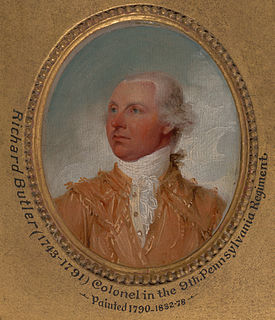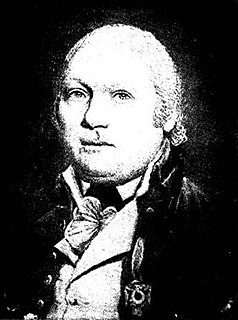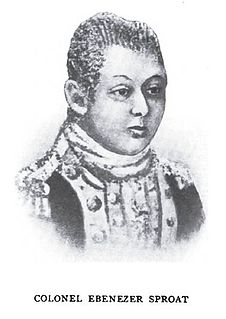| John Armstrong | |
|---|---|
| Born | April 20, 1755 New Jersey |
| Died | February 4, 1816 (aged 60) Clark County, Indiana |
John Armstrong (April 20, 1755 – February 4, 1816) was an American soldier and judge. He was born in New Jersey. During the American Revolutionary War he served as an officer in the Continental Army with the 12th Pennsylvania Regiment and the 3rd Pennsylvania Regiment. His service record is sometimes confused with the more famous John Armstrong, Jr., a Pennsylvania officer who became U.S. Secretary of War.

The American Revolutionary War (1775–1783), also known as the American War of Independence, was an 18th-century war between Great Britain and its Thirteen Colonies which declared independence as the United States of America.
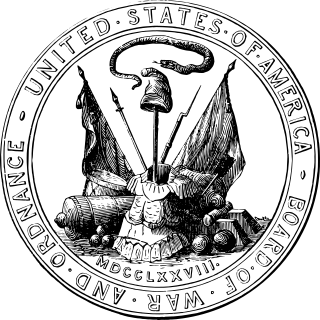
The Continental Army was formed by the Second Continental Congress after the outbreak of the American Revolutionary War by the ex-British colonies that became the United States of America. Established by a resolution of the Congress on June 14, 1775, it was created to coordinate the military efforts of the Thirteen Colonies in their revolt against the rule of Great Britain. The Continental Army was supplemented by local militias and volunteer troops that remained under control of the individual states or were otherwise independent. General George Washington was the commander-in-chief of the army throughout the war.
The 12th Pennsylvania Regiment also known as Northampton and Northumberland Defense Battalion was an American infantry unit that fought during the American Revolutionary War as part of the Continental Army. The regiment was raised 23 August 1776 at Sunbury, Pennsylvania as a state militia regiment and later renamed the 12th Pennsylvania. In January 1777 the 12th was commanded by Colonel William Cooke at Princeton. Assigned to Thomas Conway's 3rd Pennsylvania Brigade, the regiment would see action at Brandywine, Germantown, and Monmouth. The regiment was merged into the 3rd Pennsylvania Regiment shortly after Monmouth and went out of existence.
Armstrong rejoined the United States Army in 1784 and served during the Northwest Indian War. In 1790, General Josiah Harmar sent him on an exploration mission in the Northwest Territory. Later that year he led a detachment of regular soldiers that accompanied Kentucky militia under Colonel John Hardin in an expedition to attack a Native American village on the Eel River. The Americans were ambushed in the battle; the militia fled and Armstrong barely escaped with his life. He resigned from the Army in March 1793.

The United States Army (USA) is the land warfare service branch of the United States Armed Forces. It is one of the seven uniformed services of the United States, and is designated as the Army of the United States in the United States Constitution. As the oldest and most senior branch of the U.S. military in order of precedence, the modern U.S. Army has its roots in the Continental Army, which was formed to fight the American Revolutionary War (1775–1783)—before the United States of America was established as a country. After the Revolutionary War, the Congress of the Confederation created the United States Army on 3 June 1784 to replace the disbanded Continental Army. The United States Army considers itself descended from the Continental Army, and dates its institutional inception from the origin of that armed force in 1775.
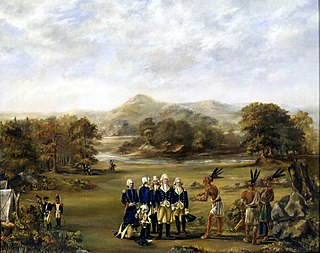
The Northwest Indian War (1785–1795), also known as the Ohio War, Little Turtle's War, and by other names, was a war between the United States and a confederation of numerous Native American tribes, with support from the British, for control of the Northwest Territory. It followed centuries of conflict over this territory, first among Native American tribes, and then with the added shifting alliances among the tribes and the European powers of France and Great Britain, and their colonials.

Josiah Harmar was an officer in the United States Army during the American Revolutionary War and the Northwest Indian War. He was the senior officer in the Army for six years and seven months.
After the war, he served as treasurer of the Northwest Territory, a judge in Hamilton County, Ohio, and as magistrate in Columbia, Ohio. He spent his final years in Clark County, Indiana, where he died.

Hamilton County is a county in the southwest corner of the U.S. state of Ohio. As of the 2010 census, the population was 802,374. making it the third-most populous county in Ohio. The county seat is Cincinnati. The county is named for the first Secretary of the Treasury, Alexander Hamilton.

Columbia-Tusculum is the oldest neighborhood in Cincinnati, Ohio and is located on the East Side of the city. The population was 1,304 at the 2010 census.

Clark County is a county located in the U.S. state of Indiana, located directly across the Ohio River from Louisville, Kentucky. At the 2010 Census, the population was 110,232. The county seat is Jeffersonville.



